How the International Date Line got all crazy in Polynesia
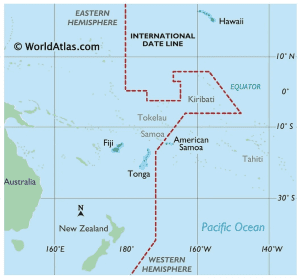
This article explains the crazy jaunt the International Date Line takes as it circumvents various Polynesian nations
In December of 2011, Samoa and the neighboring island of Tokelau moved the position of the International Date Line, effectively erasing December 31, 2011 from existence. Their purpose was to align the islands’ time with key trading partners in the Asia-Pacific region. As reported at the time by (Duk Han Lee of the Canadian Broadcast Company, “this was hardly the first-time countries have changed. Calendar systems are a representation of seasons and events, and adjustments are made as needed. For instance, Leap Year adds a day at the end of February every four years.
Interestingly enough, American Samoa, which is an unincorporated territory of the United States, chose to remain to the west of the timeline. Therefore, Samoa is placed to be one of the first to welcome the New Year, while American Samoan, a mere 137 miles to the east, is the last to say good-bye to the previous year 24 hours later.
Samoa and American Samoa are not the only nations bordering this imaginary line that runs from the North to the South Pole. To begin with, the line ‘adjusts’ to travel between Russia’s eastern border and Alaska’s western shores. From there, it travels across the largest ocean in the world with only small, unincorporated islands until it meets up with Kiribati who moved their border to take advantage of being one of the first nations to welcome the new day. An interesting side fact is that Hawaiʻi is due north of Kiribati by 1,250 miles, but because they remain east of the timeline, Hawaiʻi remains a day behind Kiribati.
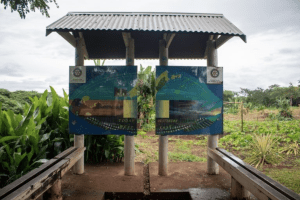
This unassuming sign indicates where the 180 Meridan crosses through the island of Taveuni.
Fiji was split, but now isn’t
Fiji also exists along the original straight edge of the International Date Line, which effectively divided its calendar dependent on what island, and in some cases, what part of the island, one lived on. The majority of Fijian islands are situated to the left of the 1800 meridian, however three islands — Vanua Levu, Rambi and Taveuni — are the only islands where that division actually touches land beyond the two polar land regions (per Royal Observatory in Greenwich). That means that people could literally jump from one day to the next by simply hoping over a think imaginary line. It was great fun, as people could actually be able to jump across an entire year just by stepping back and forth across the line on the ground on New Year’s Eve.
The problem was that this caused many issues for the nation of Fiji. Deadlines, holidays, bookkeeping, even vacations, constantly had to be modified to accommodate the dates. By the time the year 2000 was approaching (which meant that for 24 hours, one could have actually jumped from one century to another, which is a bit mindboggling), Fiji knew that something had to be done. To mark the new millennium, and to address the ensuring issues it would create, Fiji petitioned to move the International Date Line to the east of their islands. Continuity was established and governmental headaches were resolved. Good job, Fiji!
Why does the position of this imaginary line really matter?
According to the article “Millennium”, by Aimee Harris, published in August 1999, “…many South Pacific islands (were jockeying) for position along the International Date Line, in a struggle to be the first place on Earth where each calendar day begins.”
It’s a complicated matter, obviously, based on tourism, family, and convenience. Keep your eyes and ears open. This imaginary line seems to have a mind of its own, undulating across high seas in a quest to do what’s best for each island nation.
How is New Year celebrated across Polynesia?
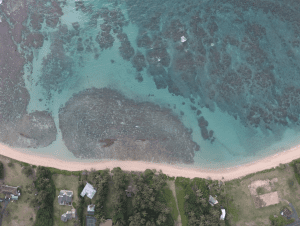
First up each New Year is Kiribati
Kiribati
First up in celebrating the coming year is the island of Kiribati, an independent nation considered part of Micronesia. Their celebration is not just the first in the Pacific, mind you, the first nation in the world. Residents keep their merry making low-key, but tourists will find small but colorful celebrations at local hotels and eateries.
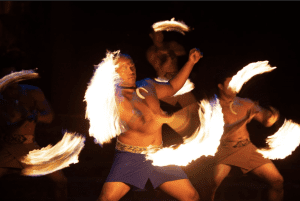
Samoan is the birthplace of fireknife dancing, so expect to see lots of heat on New Years!
Samoa
A close second is Samoa. Later you will see how this nation and its close neighbor, American Samoa, make for a workable way to celebrate New Year’s first and last. This makes it a very popular place and time to visit, so expect lots of parties, fireworks, and dancing, all with the friendly revelry and good humor Samoa is known for!
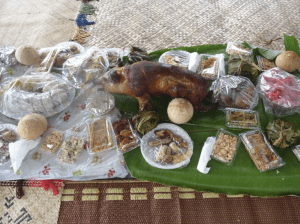
A typical Tongan family feast for New Years – Image courtesy of eurodialyouth2016.com
Tonga
In Tonga, the only Polynesian nation that still has a ruling monarchy government, New Year’s is seen more as a family activity and the opportunity to reflect on the many things Tongans can be thankful for. Numerous residents celebrate the New Year by attending church services which can be held at sunset, while others are held at midnight. The air is filled with melodic and enthusiastic singing with intricate and beautiful songs of faith and celebration. It is an experience sure to make a lasting impression.
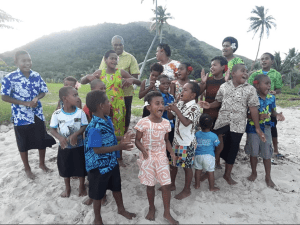
Fijian villagers singing on the beach
Fiji
Fijians take New Year’s seriously by holding a week-long celebration from Christmas Day to January 1st with family and their community (especially in the smaller settlements across the islands) which includes lots of food, dance and opportunities to kick it up with fun competitions and games.
Aotearoa / New Zealand
Matariki is known as the Māori New Year in Te Ao Māori (the Māori world view).But this celebration is based on the lunar calendar, which makes it land around May to June.Closely connected with the maramataka (the Māori lunar calendar), the reappearance of the Matariki stars in the early morning sky brings the past year to a close and marks the beginning of the new year.
So January 1st is strictly a non-Polynesian event. Still, it is a fun opportunity to join with the rest of the world in celebrating the Gregorian Calendar’s observance. Since January in the Southern Hemisphere occurs in the midst of their summer months, it comes as no surprise that the great outdoors takes center stage as New Zealand welcomes the New Year. A popular local New Year’s tradition is to spend the day on the beach with a rollicking nighttime celebration of fireworks. Some of the bigger displays can be found in Auckland, Wellington and Christchurch.
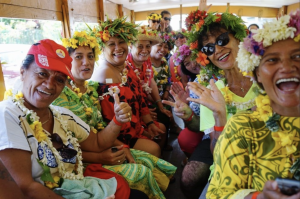
Having fun New Years Day while traveling in style1 Photo courtesy of ACTU.FR (use URL: Actu Polynésie Française | actu.fr)
Tahiti
It takes almost an entire day for the next Polynesian nation to reach the New Year mark. A uniquely traditional New Year’s event in Tahiti is a festival that helps revelers to travel with flare by utilizing a “Le Tere Fa’ati” (a mobile celebration that is utilized for special occasions throughout the year). Open air buses, which are decorated specially for the event, travel to popular local attractions. Each bus contains local musicians who play musical instruments such as the drum and ukulele at various stops. https://www.newyearsevelive.net/australaisa.html
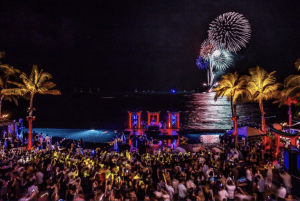
Waikiki Beach has multiple places to celebrate the New Year (photo courtesy of Hawaii Magazine)
Hawaiʻi
First off, let’s review how to say “Happy New Year” in Hawaiʻi.
Because makahiki also means “year”, the Hawaiian phrase for “Happy New Year” becomes “Hau’oli (happy) Makahiki (year) Hou (new)”(how-OH-lee mah-kah-hee-kee ho).
Due to a high influx of migrant workers during plantation days Hawaiʻi has its own version of a cultural melting pot. Many families mark the occasion with a trip to the beach with extended family, the pounding of the traditional Japanese dish of Mochi, which is very popular on the islands and neighborhood fireworks that put most other celebrations to shame.
The country town of Lāʻie used to hold a popular neighborhood fireknife dance competition. Don’t let the quaint setting fool you. Hawaiʻi is home to many champion fireknife dancers, and renowned dancers were known to travel in from other islands and even the US mainland. Throwing aside the traditional rules, this neighborhood competition was open to innovation. Though, sadly, this competition was discontinued a few years back, Lāʻie is still home to the yearly World Fireknife Championship held at the Polynesian Cultural Center in May.
Want to see an entertaining film that showcases a lighthearted competition between the OG’s (Old Guys) of Fireknife vs. the NG’s (New Guys)? This fun video made by YouTube star “Supertramp” (Devin Graham) is a perfect example of both traditional fireknife and modern innovation.
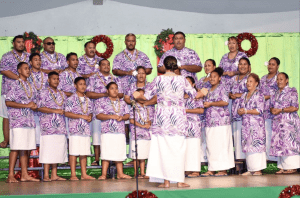
Sa’ilele Catholic Church Choir photo courtesy of American Samoa Government Facebook page
American Samoa
After traveling all around the world, the New Year eventually comes full circle.
The last country to ring in is American Samoa. Their festivities are held a full 25 hours after their closest neighbor (Samoa) held their own celebration. This substantial gap actually makes it possible to board a plane following your Samoan celebration and head over to American Samoa to do it all again. It has been done!
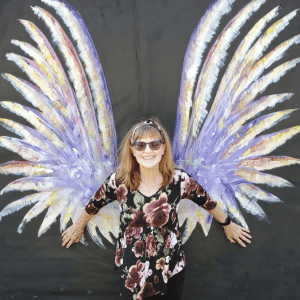 Nina Jones, a mainland gal from way back, is now a transplanted Islander. With her husband of 45+ years, she has been thrilled to live in the beautiful village of Laʻie for the past 8 years. Her hobbies include swimming, traveling, studying and writing about what she is learning from the various Polynesian cultures. Her blogs focus on their history, beliefs, practices and – as an added bonus – delicious food! To her, Polynesia is not just a place to visit, it is a way to live and she is very honored to be able to be a part of their amazing world.
Nina Jones, a mainland gal from way back, is now a transplanted Islander. With her husband of 45+ years, she has been thrilled to live in the beautiful village of Laʻie for the past 8 years. Her hobbies include swimming, traveling, studying and writing about what she is learning from the various Polynesian cultures. Her blogs focus on their history, beliefs, practices and – as an added bonus – delicious food! To her, Polynesia is not just a place to visit, it is a way to live and she is very honored to be able to be a part of their amazing world.

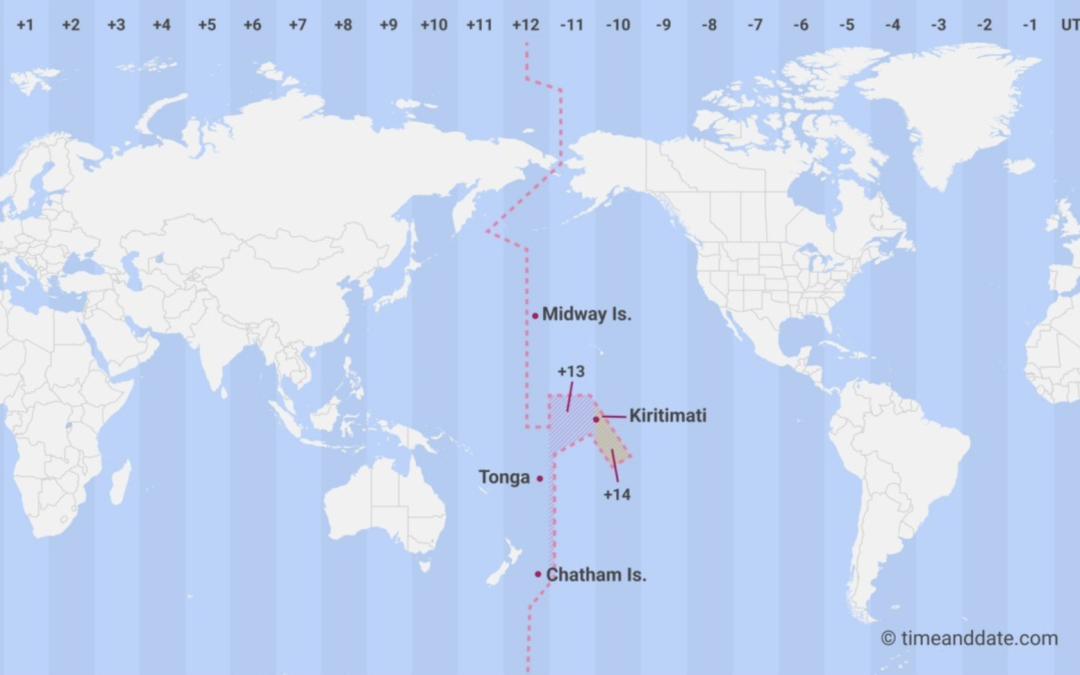
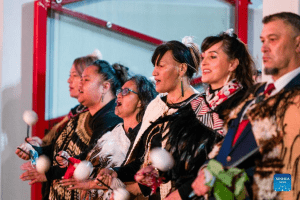
Recent Comments